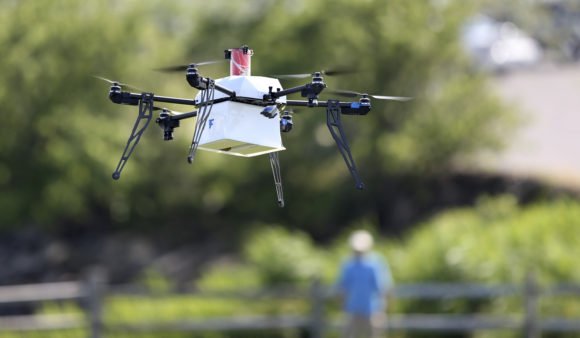How to distribute lifesaving supplies quickly and safely after a natural disaster has long been a puzzle for responders. Now, drones might be the lifesaver.
That idea was put to the test last month in New Jersey as a drone delivery service conducted test flights to help determine whether drones can be used to carry human medical samples to and from areas that cannot be accessed or communicated with during major storms, earthquakes or other disasters.
Experts say drones are becoming a more valuable tool in many humanitarian operations, where the unmanned aircraft can be quickly launched and used to collect data and images and help locate people who might be injured or trapped. But Timothy Amukele, an assistant professor of pathology at the Johns Hopkins University School of Medicine in Baltimore, said that biological samples “are not like a shoe or a book; they are pretty fragile items.”
“For example, if blood is being carried on the back of motorcycle, shaking caused by the bike and its vibrations can ruin the sample,” said Amukele, a volunteer adviser to Flirtey, the company that conducted the tests in New Jersey. “We want to see what tasks the drones can perform and if the drones have similar effects on samples they carry.”
About 100 people looked on as the drones flew between an onshore medical relief camp and a test facility on a vessel stationed on the Delaware Bay. They took medical supplies from the vessel to the medical camp, while blood and other medical specimens were flown between the sites.
Matt Sweeny, Flirtey’s chief executive, believes medical drone delivery will happen “more quickly than people realize,” possibly within the next three years. He says such a service could potentially help hundreds of thousands of people, noting the number of residents affected by Superstorm Sandy.
Amukele believes it will probably take about five years before drones are used regularly in disaster situations. He notes that roughly 59 nations currently have drone regulations, so responders will need to know what rules other countries will put in place.
Was this article valuable?
Here are more articles you may enjoy.



 Home Insurance at $10,000 a Year Shows California Buyers’ Pain
Home Insurance at $10,000 a Year Shows California Buyers’ Pain  Zurich to Buy AIG’s Travel Insurance Business for $600 Million
Zurich to Buy AIG’s Travel Insurance Business for $600 Million  Farmers Adjusters Cry Foul Over Workloads, Claims Handling in Letter to Regulators
Farmers Adjusters Cry Foul Over Workloads, Claims Handling in Letter to Regulators  US Roof Maintenance Lags: Hanover
US Roof Maintenance Lags: Hanover 


